MaOpy2, a Transmembrane Protein, Is Involved in Stress Tolerances and Pathogenicity and Negatively Regulates Conidial Yield by Shifting the Conidiation Pattern in Metarhizium acridum
Abstract
:1. Introduction
2. Materials and Methods
2.1. Strains and Vector Construction
2.2. Phenotypic and Pathogenicity Analyses
2.3. Growth of Fungi in Locust Hemolymph In Vitro and Appressorium Induction on Locust Wings
2.4. Microscopic Observation of the Conidiation Pattern and Different Expression Genes (DEGs) by RNA-seq
2.5. Statistical Analysis
3. Results
3.1. Characteristics of MaOpy2
3.2. Disruption of MaOpy2 Decreased Fungal Tolerances to UV-B Irradiation, Heat Shock, and Cell-Wall-Perturbing Agents
3.3. Deletion of MaOpy2 Impaired the Insect Cuticle Penetration of M. acridum
3.4. Deletion of MaOpy2 Enhanced the Colonized Ability of M. acridum in Locust Hemolymph
3.5. Deletion of MaOpy2 Increased Fungal Conidial Yield by Shifting the Conidiation Pattern
3.6. Identification of the DEGs Regulated by MaOpy2 during a Conidiation Pattern Shift Using RNA-seq
4. Discussion
Supplementary Materials
Author Contributions
Funding
Institutional Review Board Statement
Informed Consent Statement
Data Availability Statement
Conflicts of Interest
References
- Clarkson, J.M.; Charnley, A.K. New insights into the mechanisms of fungal pathogenesis in insects. Trends. Microbiol. 1996, 4, 197–203. [Google Scholar] [CrossRef]
- Ortiz-Urquiza, A.; Luo, Z.B.; Keyhani, N.O. Improving mycoinsecticides for insect biological control. Appl. Microbiol. Biotechnol. 2015, 99, 1057–1068. [Google Scholar] [CrossRef] [PubMed]
- Brodeur, J. Host specificity in biological control: Insights from opportunistic pathogens. Evol. Appl. 2012, 5, 470–480. [Google Scholar] [CrossRef] [PubMed]
- Zarrin, M.; Rahdar, M.; Gholamian, A. Biological Control of the Nematode Infective larvae of Trichostrongylidae Family With Filamentous Fungi. Jundishapur. J. Microbiol. 2015, 8, e17614. [Google Scholar] [CrossRef] [Green Version]
- Rangel, D.E.; Braga, G.U.; Anderson, A.J.; Roberts, D.W. Influence of growth environment on tolerance to UV-B radiation, germination speed, and morphology of Metarhizium anisopliae var. acridum conidia. J. Invertebr. Pathol. 2005, 90, 55–58. [Google Scholar] [CrossRef]
- Thomas, M.B.; Read, A.F. Can fungal biopesticides control malaria? Nat. Rev. Microbiol. 2007, 5, 377–383. [Google Scholar] [CrossRef]
- Thompson, S.R.; Brandenburg, R.L.; Arends, J.J. Impact of moisture and UV degradation on Beauveria bassiana (Balsamo) Vuillemin conidial viability in turfgrass. Biol. Control 2006, 39, 401–407. [Google Scholar] [CrossRef]
- Ferron, P. Biological Control of Insect Pests by Entomogenous Fungi. Annu. Rev. Entomol. 1978, 23, 409–442. [Google Scholar] [CrossRef]
- Hanlin, R. Microcycle conidiation—A review. Mycoscience 1994, 35, 113–123. [Google Scholar] [CrossRef]
- Jung, B.; Kim, S.; Lee, J. Microcyle conidiation in filamentous fungi. Mycobiology 2014, 42, 1–5. [Google Scholar] [CrossRef] [Green Version]
- Anderson, J.G.; Smith, J.E. The production of conidiophores and conidia by newly germinated conidia of Aspergillus niger (microcycle conidiation). J. Gen. Microbiol. 1971, 69, 185–197. [Google Scholar] [CrossRef] [PubMed] [Green Version]
- Pažout, J.; Schröder, P. Microcycle conidiation in submerged cultures of Penicillium cyclopium attained without temperature changes. J. Gen. Microbiol. 1988, 134, 2685–2692. [Google Scholar] [PubMed] [Green Version]
- Vezina, C.; Singh, K.; Sehgal, S.N. Sporulation of filamentous fungi in submerged culture. Mycologia 1965, 57, 722–736. [Google Scholar] [CrossRef]
- Bosch, A.; Yantorno, O. Microcycle conidiation in the entomopathogenic fungus Beauveria bassiana bals. (vuill.). Process Biochem. 1999, 34, 707–716. [Google Scholar] [CrossRef]
- Zhang, S.Z.; Peng, G.X.; Xia, Y.X. Microcycle conidiation and the conidial properties in the entomopathogenic fungus Metarhizium acridum on agar medium. Biocontrol Sci. Techn. 2010, 20, 809–819. [Google Scholar] [CrossRef]
- Wu, C.; Jansen, G.; Zhang, J.C.; Thomas, D.Y.; Whiteway, M. Adaptor protein Ste50p links the Ste11p MEKK to the HOG pathway through plasma membrane association. Genes Dev. 2006, 20, 734–746. [Google Scholar] [CrossRef] [Green Version]
- Herrero de Dios, C.; Roman, E.; Diez, C.; Alonso-Monge, R.; Pla, J. The transmembrane protein Opy2 mediates activation of the Cek1 MAP kinase in Candida albicans. Fungal Genet. Biol. 2013, 50, 21–32. [Google Scholar] [CrossRef] [Green Version]
- Guo, N.; Qian, Y.; Zhang, Q.Q.; Chen, X.X.; Zeng, G.H.; Zhang, X.; Mi, W.B.; St Leger, R.; Fang, W.G. Alternative transcription start site selection in Mr-OPY2 controls lifestyle transitions. Nat. Commun. 2017, 8, 1565. [Google Scholar] [CrossRef] [Green Version]
- Cai, Y.Y.; Wang, J.Y.; Wu, X.Y.; Liang, S.; Zhu, X.M.; Li, L.; Lu, J.P.; Liu, X.H.; Lin, F.C. MoOpy2 is essential for fungal development, pathogenicity, and autophagy in Magnaporthe oryzae. Environ. Microbiol. 2022, 24, 1653–1671. [Google Scholar] [CrossRef]
- Wen, Z.Q.; Tian, H.T.; Xia, Y.X.; Jin, K. MaPmt1, a protein O-mannosyltransferase, contributes to virulence through governing the appressorium turgor pressure in Metarhizium acridum. Fungal Genet. Biol. 2020, 145, 103480. [Google Scholar] [CrossRef]
- Wen, Z.Q.; Xia, Y.X.; Jin, K. MaSln1, a Conserved Histidine Protein Kinase, Contributes to Conidiation Pattern Shift Independent of the MAPK Pathway in Metarhizium acridum. Microbiol. Spectr. 2022, 10, e0205121. [Google Scholar] [CrossRef] [PubMed]
- He, M.; Xia, Y.X. Construction and analysis of a normalized cDNA library from Metarhizium anisopliae var. acridum germinating and differentiating on Locusta migratoria wings. FEMS Microbiol. Lett. 2009, 291, 127–135. [Google Scholar] [CrossRef] [PubMed] [Green Version]
- Wang, C.S.; St Leger, R.J. The Metarhizium anisopliae perilipin homolog MPL1 regulates lipid metabolism, appressorial turgor pressure, and virulence. J. Biol. Chem. 2007, 282, 21110–21115. [Google Scholar] [CrossRef] [PubMed] [Green Version]
- Zhang, Q.P.; Peng, G.X.; Wang, Z.K.; Yin, Y.P.; Xia, Y.X. Detection of Metarhizium anisopliae rDNA in haemalymph of infected adult locust by real-time fluorescence quantitative PCR. Chin. Prog. Biotech. 2005, 25, 71–75. [Google Scholar]
- Zhang, J.J.; Jiang, H.; Du, Y.R.; Keyhani, N.O.; Xia, Y.X.; Jin, K. Members of chitin synthase family in Metarhizium acridum differentially affect fungal growth, stress tolerances, cell wall integrity and virulence. PLoS Pathog. 2019, 15, e1007964. [Google Scholar] [CrossRef]
- Kitagaki, H.; Wu, H.; Shimoi, H.; Ito, K. Two homologous genes, DCW1 (YKL046c) and DFG5, are essential for cell growth and encode glycosylphosphatidylinositol (GPI)-anchored membrane proteins required for cell wall biogenesis in Saccharomyces cerevisiae. Mol. Microbiol. 2002, 46, 1011–1022. [Google Scholar] [CrossRef]
- Yu, D.; Zhang, S.J.; Li, X.P.; Xu, J.R.; Schultzhaus, Z.; Jin, Q.J. A Gin4-Like Protein Kinase GIL1 Involvement in Hyphal Growth, Asexual Development, and Pathogenesis in Fusarium graminearum. Int. J. Mol. Sci. 2017, 18, 424. [Google Scholar] [CrossRef] [Green Version]
- Ryder, L.S.; Dagdas, Y.F.; Kershaw, M.J.; Venkataraman, C.; Madzvamuse, A.; Yan, X.; Cruz-Mireles, N.; Soanes, D.M.; Oses-Ruiz, M.; Styles, V.; et al. A sensor kinase controls turgor-driven plant infection by the rice blast fungus. Nature 2019, 574, 423–427. [Google Scholar] [CrossRef]
- Cross, A.R.; Jones, O.T. The effect of the inhibitor diphenylene iodonium on the superoxide-generating system of neutrophils. Specific labelling of a component polypeptide of the oxidase. Biochem. J. 1986, 237, 111–116. [Google Scholar] [CrossRef] [Green Version]
- Howard, R.J.; Ferrari, M.A.; Roach, D.H.; Money, N.P. Penetration of hard substrates by a fungus employing enormous turgor pressures. Proc. Natl. Acad. Sci. USA 1991, 88, 11281–11284. [Google Scholar] [CrossRef] [Green Version]
- Latgé, J.P. The cell wall: A carbohydrate armour for the fungal cell. Mol. Microbiol. 2007, 66, 279–290. [Google Scholar] [CrossRef] [PubMed]
- Zhao, T.T.; Wen, Z.Q.; Xia, Y.X.; Jin, K. The transmembrane protein MaSho1 negatively regulates conidial yield by shifting the conidiation pattern in Metarhizium acridum. Appl. Microbiol. Biotechnol. 2020, 104, 4005–4015. [Google Scholar] [CrossRef] [PubMed]
- Hart, R.J.; Lawres, L.; Fritzen, E.; Ben Mamoun, C.; Aly, A.S. Plasmodium yoelii vitamin B5 pantothenate transporter candidate is essential for parasite transmission to themosquito. Sci. Rep. 2014, 4, 5665. [Google Scholar] [CrossRef] [PubMed] [Green Version]
- Li, C.R.; Yong, J.; Wang, Y.M.; Wang, Y. CDK regulates septin organization through cell-cycle-dependent phosphorylation of the Nim1-related kinase Gin4. J. Cell Sci. 2012, 125, 2533–2543. [Google Scholar] [CrossRef] [Green Version]
- Meitinger, F.; Pereira, G. The septin-associated kinase Gin4 recruits Gps1 to the site of cell division. Mol. Biol. Cell 2017, 28, 883–889. [Google Scholar] [CrossRef] [Green Version]
- Jasani, A.; Huynh, T.; Kellogg, D.R. Growth-Dependent Activation of Protein Kinases Suggests a Mechanism for Measuring Cell Growth. Genetics 2020, 215, 729–746. [Google Scholar] [CrossRef]
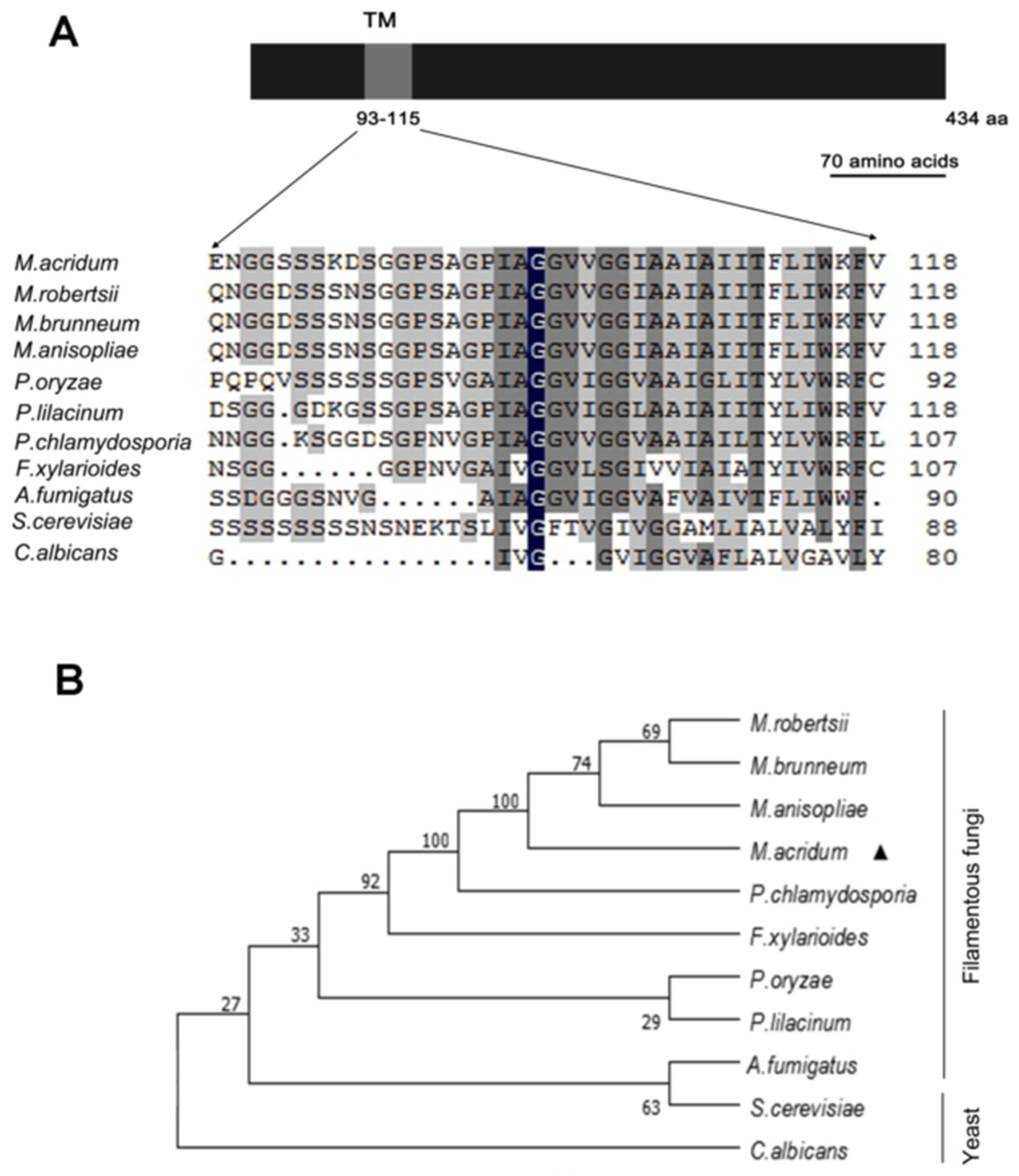
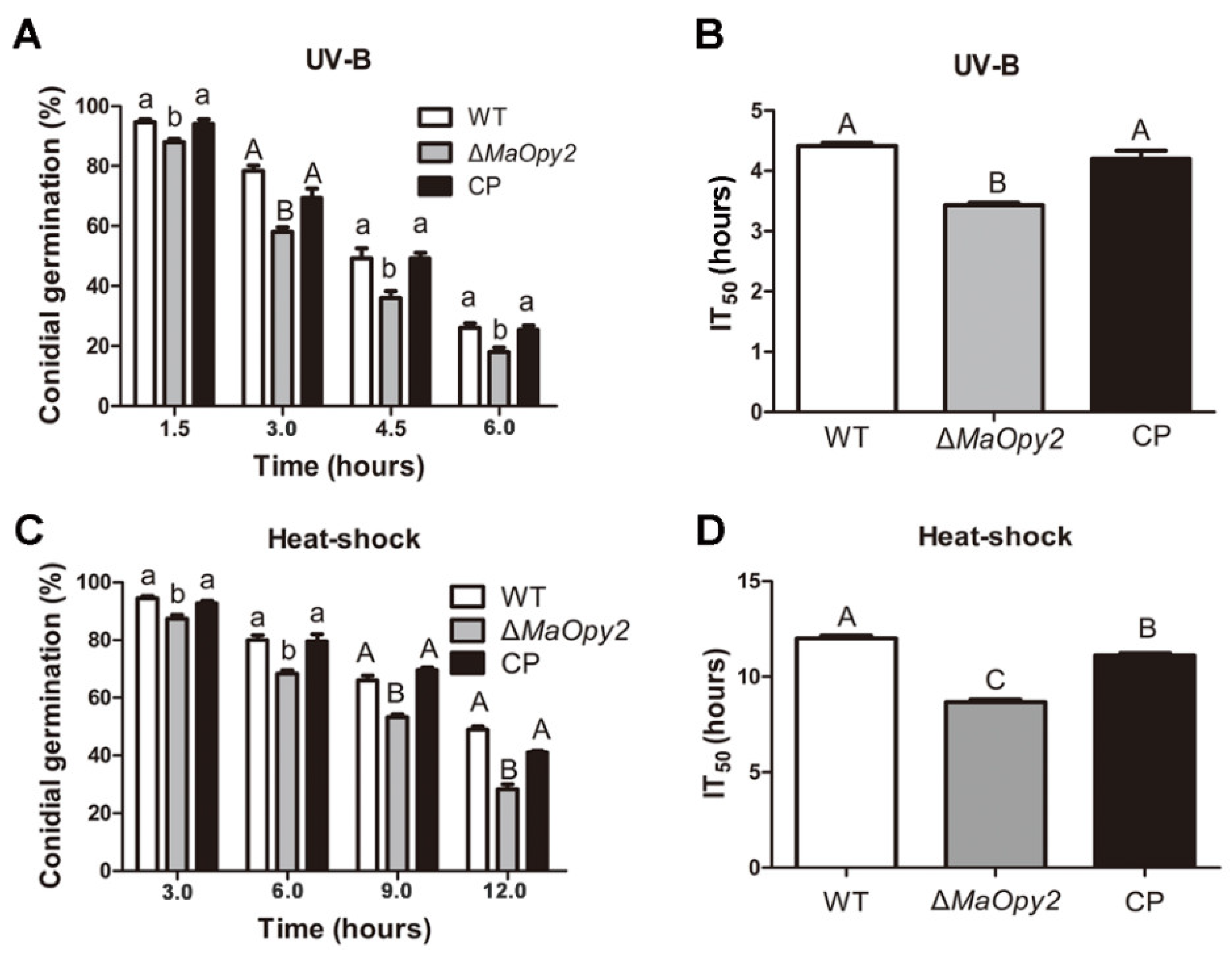


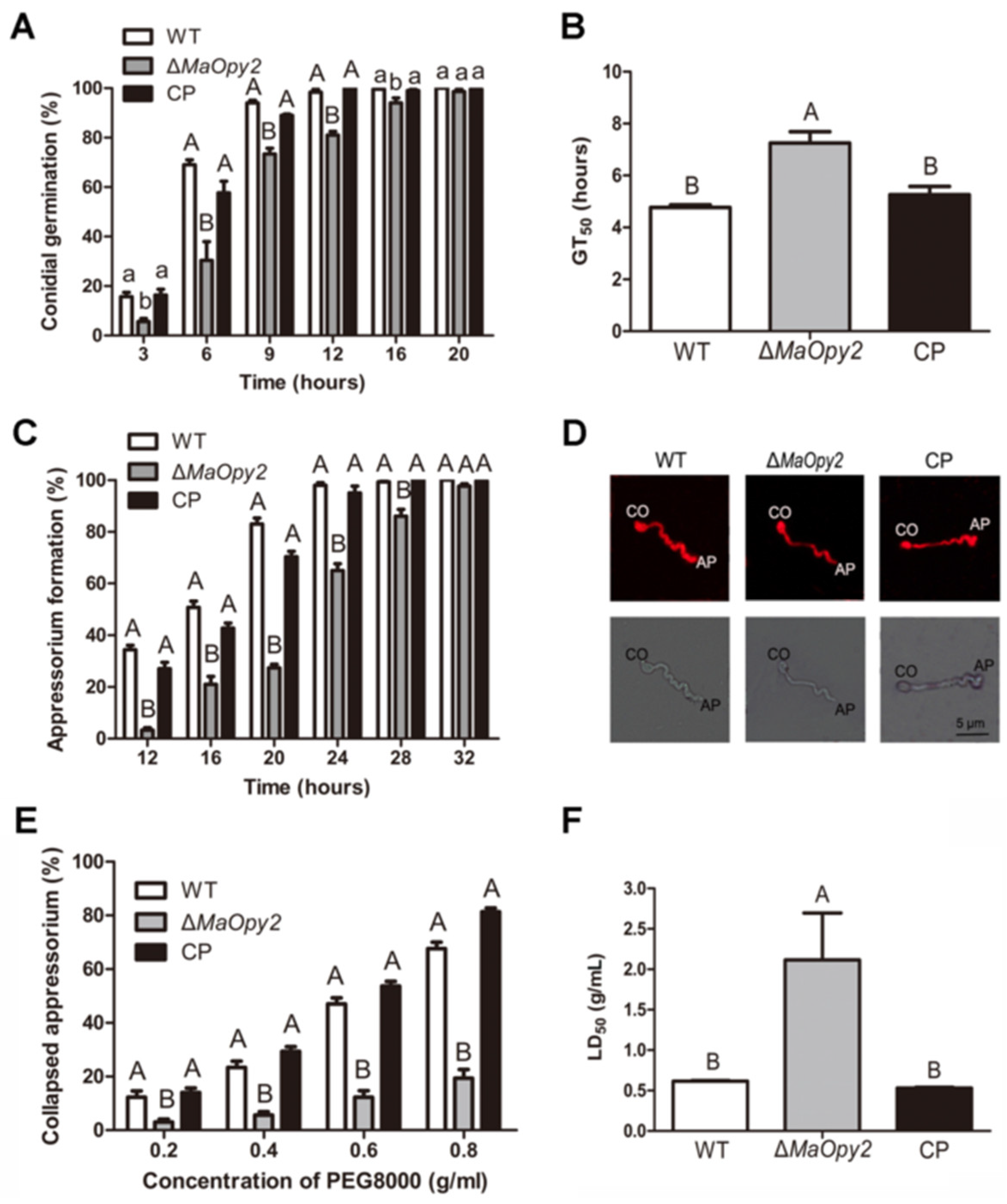
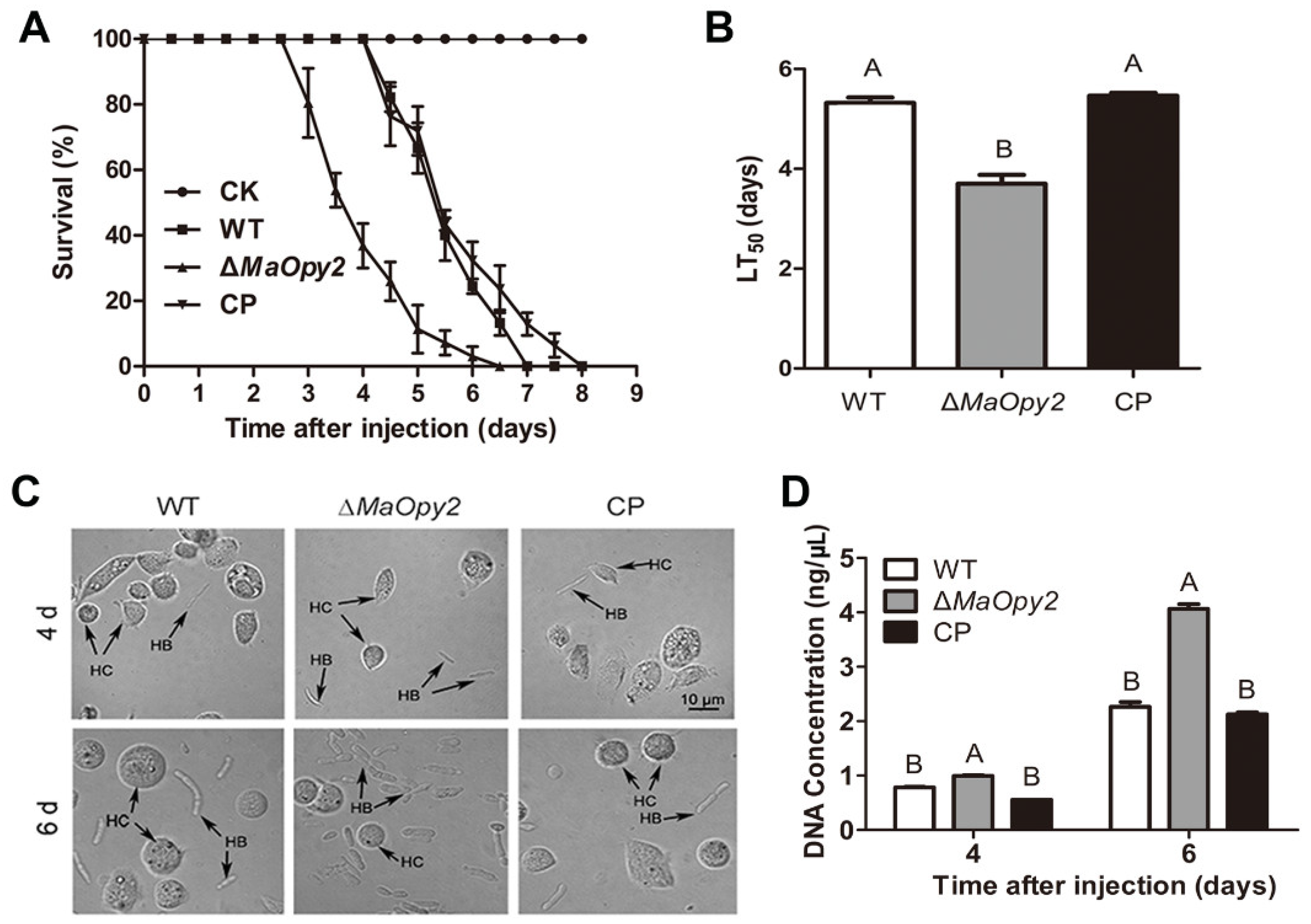


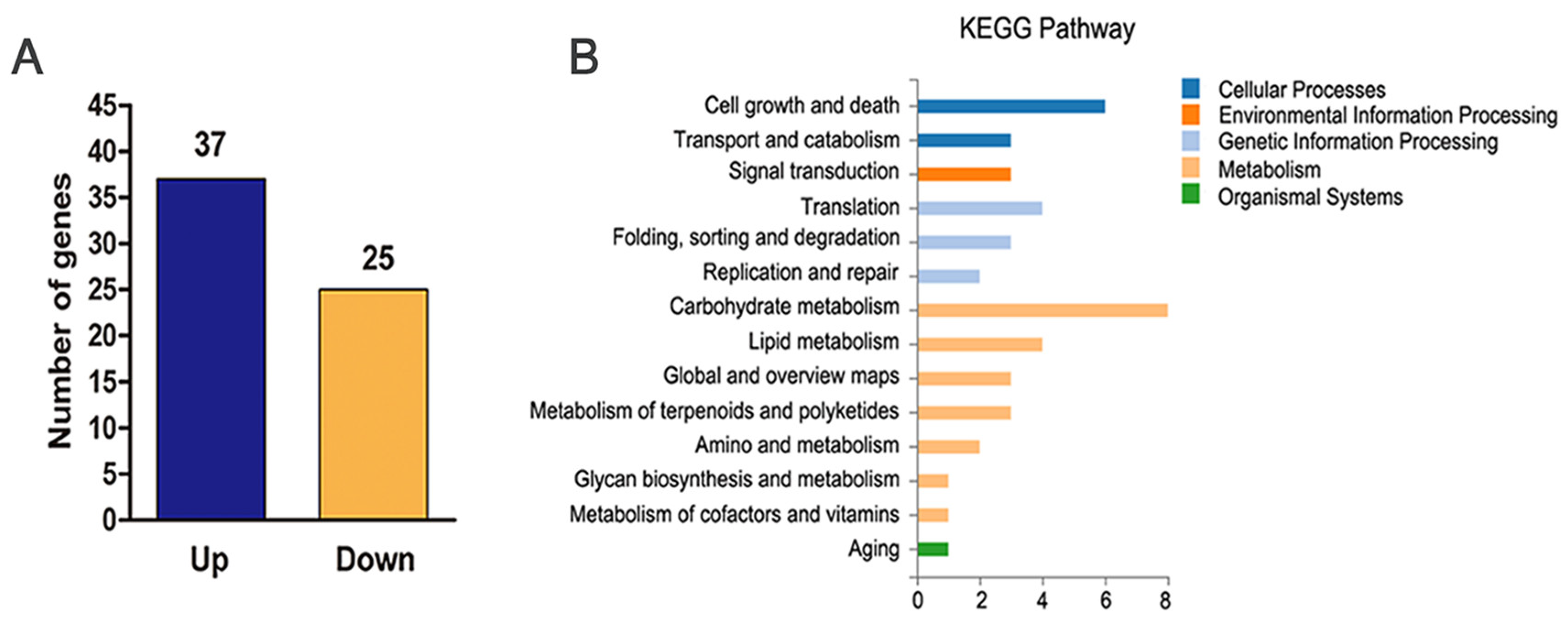
Publisher’s Note: MDPI stays neutral with regard to jurisdictional claims in published maps and institutional affiliations. |
© 2022 by the authors. Licensee MDPI, Basel, Switzerland. This article is an open access article distributed under the terms and conditions of the Creative Commons Attribution (CC BY) license (https://creativecommons.org/licenses/by/4.0/).
Share and Cite
Wen, Z.; Fan, Y.; Xia, Y.; Jin, K. MaOpy2, a Transmembrane Protein, Is Involved in Stress Tolerances and Pathogenicity and Negatively Regulates Conidial Yield by Shifting the Conidiation Pattern in Metarhizium acridum. J. Fungi 2022, 8, 587. https://doi.org/10.3390/jof8060587
Wen Z, Fan Y, Xia Y, Jin K. MaOpy2, a Transmembrane Protein, Is Involved in Stress Tolerances and Pathogenicity and Negatively Regulates Conidial Yield by Shifting the Conidiation Pattern in Metarhizium acridum. Journal of Fungi. 2022; 8(6):587. https://doi.org/10.3390/jof8060587
Chicago/Turabian StyleWen, Zhiqiong, Yu Fan, Yuxian Xia, and Kai Jin. 2022. "MaOpy2, a Transmembrane Protein, Is Involved in Stress Tolerances and Pathogenicity and Negatively Regulates Conidial Yield by Shifting the Conidiation Pattern in Metarhizium acridum" Journal of Fungi 8, no. 6: 587. https://doi.org/10.3390/jof8060587
APA StyleWen, Z., Fan, Y., Xia, Y., & Jin, K. (2022). MaOpy2, a Transmembrane Protein, Is Involved in Stress Tolerances and Pathogenicity and Negatively Regulates Conidial Yield by Shifting the Conidiation Pattern in Metarhizium acridum. Journal of Fungi, 8(6), 587. https://doi.org/10.3390/jof8060587





